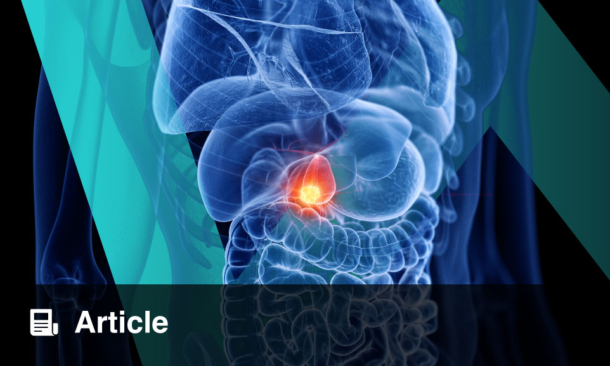Author: Helena Bradbury, EMJ, London, UK
Citation: EMJ Gastroenterol. 2025;14[1]:24-27. https://doi.org/10.33590/emjgastroenterol/WSCL3189
![]()
AT THE 2025 United European Gastroenterology (UEG) Week held in Berlin, Germany, an informative session explored emerging approaches for the management of ulcerative colitis (UC), ranging from surgical interventions to updated treatment guidelines and novel therapeutics. It highlighted research on appendectomy as a potential treatment, updated clinical guidelines in the management of paediatric ulcerative colitis care, and the evolving use of combination therapies to enhance patient outcomes.
APPENDECTOMY: THE SOLUTION FOR ULCERATIVE COLITIS?
Eva Visser, Amsterdam University Medical Center, the Netherlands, first discussed appendectomy as a potential solution to UC. She began by exploring the history of the association between the appendix and UC, which was first described in a 1987 study reporting a lower appendectomy rate in patients with UC compared with healthy controls. What causes this association? To answer, Visser explored several theories; it could act as a reservoir to re-establish commensal bacteria or serve an immunological function as it contains lymphoid tissue. When these processes become dysregulated, as hypothesised by Visser, it can be the primary site for UC.
Following on, she posed the question of “whether an appendectomy can actually alter the disease course in ulcerative colitis.” The ACCURE trial,1 an international RCT, looked to evaluate the clinical effectiveness of laparoscopic appendectomy in maintaining remission in patients with UC. Patients aged >18 years with UC who were in complete remission were randomised to an appendectomy and standard therapy, or standard therapy alone. Interestingly, the results demonstrated that an appendectomy was superior at maintaining remission at 1 year. The relapse rate was 36.4% in the appendectomy arm compared to 56.1% in the control arm.1
After observing an inverse relationship between appendectomies and the development of UC, researchers next sought to determine whether this association also extended to patients with active disease. The PASSION trial2 was an observational study that assessed patients with therapy-refractory UC referred for proctocolectomy, who were invited to undergo laparoscopic appendectomy first. The findings showed that after 12 months, nine patients (30%) had lasting clinical response, of whom five (17%) were in endoscopic remission.2
Finally, moving away from observational studies, Visser drew attention to COSTA (Visser E et al., unpublished data), the first controlled, multi-centre, patient-preference, international cohort trial. It comprised 116 patients with biologic-exposed, active UC, and looked to evaluate the efficacy of laparoscopic appendectomy in inducing remission compared with JAK inhibitor therapy in patients with active UC who failed biologic therapy. The results showed that 32.8% (22/67) of patients in the appendectomy group achieved remission at 12 months without therapy failure compared to 12.2% (6/49) in the JAK inhibitor group. As highlighted, these results showed that appendectomy was not only feasible and well-tolerated, but also effective in this hard-to-treat, biologic-exposed population (Visser E et al., unpublished data).
PAEDIATRIC ULCERATIVE COLITIS
Patrick van Rheenen, University Medical Center Groningen, the Netherlands, took the stage to share the updated guidelines for paediatric UC. He began by emphasising the importance of inflammatory bowel disease specialists having a thorough understanding of paediatric UC, as the disease is often more extensive in children. This understanding also provides crucial insight into treatment pathways before transition to adult care, and highlights the limited number of therapies currently approved for this patient population. Examples of treatment options include infliximab, adalimumab, vedolizumab, ustekinumab, and tofacitinib. However, as noted, the approval process for these therapies can take many years, with infliximab requiring 6 years, adalimumab 9 years, and several others still awaiting full approval.
Referring to the 2025 clinical guidelines,3,4 he first outlined the methodology used to ensure that they were accurate and comprehensive. This approach included the formulation of population, intervention, comparison, and outcome (PICO) frameworks; a standardised literature search; three online voting rounds; a face-to-face consensus meeting; and acceptance of statements achieving at least 80% agreement.
What has changed since the previous set of guidelines? Released in 2016, the last guidelines drew on the management of ambulatory UC and acute severe UC. Ambulatory UC is comparably more moderate than acute severe, with a Paediatric Ulcerative Colitis Activity Index (PUCAI) score of 10–60, compared to ≥65 for acute severe UC. van Rheenen emphasised that the treatment for mild-to-moderate UC has largely not changed since the 2016 guidelines, with changes only noticeable in relation to the management of severe disease or those requiring more than conventional therapy. The updated guidelines highlighted higher dosing of infliximab for both ambulatory and acute severe colitis, the importance of therapeutic drug monitoring with anti-TNFs, the use of other advanced therapies, the emerging role of intestinal ultrasounds, and the sequencing of new treatments in advanced severe UC.
On the first change, in relation to higher dosing of infliximab and proactive therapeutic drug monitoring, van Rheenen explained that, for ambulatory UC, in most cases there is 10 mg/dose at Weeks 0, 2, and 6, followed by 10 mg/kg every 4–8 weeks for maintenance. These are required to provide the best chance of reaching the desired clinical and endoscopic outcome. For uncomplicated UC, there is recommended therapeutic drug monitoring before the fourth infliximab infusion, and therapeutic drug monitoring before the third infliximab infusion for when increased infliximab clearance is expected.
What does therapeutic drug monitoring really mean in practice? There is a range known as the ‘target through’, which means maintaining the lowest concentration of a therapeutic drug in a patient’s bloodstream to achieve the best clinical outcome. For instance, in uncomplicated UC, the target through is ≥25 mg/kg at Week 2, ≥15 mg/kg at Week 6, and 8–10 mg/kg at Week 14. The new updated clinical guidelines recommend that, for uncomplicated UC, you monitor the target through levels at Week 14 to ensure that they are not above the target range of 8–10 mg/kg. Similarly, for patients where the drug is leaving the body at a faster rate, known as increased infliximab clearance, the recommendation is to monitor the target through levels at Week 6.
Subsequently, van Rheenen guided the audience through the recommended treatment sequence for paediatric acute severe UC. On Day 1, if the PUCAI score is ≥65 points, the first-line treatment recommendation is methylprednisone. At Day 3, if the PUCAI score is ≥45 points, it is advised to transfer the patient to a referral paediatric inflammatory bowel disease centre. Finally, at Day 5, if the PUCAI score is ≥65 points, it is advised to begin the second-line treatment; infliximab, cyclosporin, or tacrolimus. van Rheenen elaborated that infliximab is recommended as the preferred second-line rescue therapy: 10 mg/kg/dose at Weeks 0, 1, and 3, followed by 10 mg/kg every 2–4 weeks. Tacrolimus or cyclosporin can be used as alternative second-line drugs, particularly in the event of infliximab failure.
To close, van Rheenen spoke on the extrapolation strategy. This is a concept suggesting that, when a drug is approved for adolescents (>12 years; >40 kg), it should also be given to children (2–12 years; <40 kg), as the pharmacokinetics between children and adolescents are consistently similar.
COMBINING THERAPIES IN ULCERATVE COLITIS
Joana Torres, Hospital Beatriz Ângelo, Loures, Portugal, explored the possibility of combining treatment strategies for UC. She highlighted that despite the increase in available therapies, efficacy rates have plateaued, with under 50% of patients achieving clinical remission at 1 year. 5
Torres explained the rationale for combination therapies, noting that monotherapy achieves limited remission rates and that targeting multiple pathways increases the likelihood of capturing responders. She added that sequentially used biologics often lose effectiveness, and that early combination therapy in UC may delay the development of anti-drug antibodies or escape mechanisms, thereby improving the durability of response.
How should one select the therapies to combine? Torres focused on advanced combination therapies, defined as the use of two targeted agents: either two biologics or a biologic paired with a small molecule. She emphasised that therapy selection should prioritise complementary, non-overlapping mechanisms of action while maintaining optimal safety profiles.
However, as Torres stressed, it is not only the choice of therapies that matters, but also the timing of their administration and the ongoing monitoring of the patient. For example, during induction therapy, the two drugs can be administered using an add-on, simultaneous, or sequential induction approach. Similarly, for maintenance, strategies may include withdrawing the first biologic, continuing both biologics, and maintaining biologic one with short, intermittent courses of the second therapy.
Torres noted that, unlike in other disease areas such as breast, lung, or colorectal cancer, advanced combination therapy in UC remains largely opportunistic and empirical. She spoke on the VEGA trial,6 a Phase II, proof-of-concept trial that published its results in 2023. It aimed to assess whether guselkumab plus golimumab combination therapy was more effective for UC than monotherapy. Ultimately, it showed that combination therapy outperformed monotherapy, where 59/71 (83%) patients in the combination therapy group had achieved clinical response compared with 44/72 (61%) patients in the golimumab monotherapy group.6
To conclude, Torres recommended the early induction of advanced combination therapies to prevent therapeutic resistance, emphasising that this should be carried out in specialised centres with the resources for adequate patient monitoring. Looking ahead, she highlighted the potential of bi-specific antibodies and nanobodies, which can target two pathways simultaneously, unlike current combination therapies that are administered separately. She also noted the promise of innovative clinical trial designs, such as platform trials, which allow multiple treatments to be tested simultaneously against a shared placebo group.
CONCLUSION
Overall, this session highlighted how rapidly the treatment landscape for UC is evolving, with innovation spanning surgery, paediatric management, and advanced therapeutic combinations. Together, these insights pointed towards a more personalised and multidisciplinary approach to improving long-term outcomes for patients living with this complex disease.







